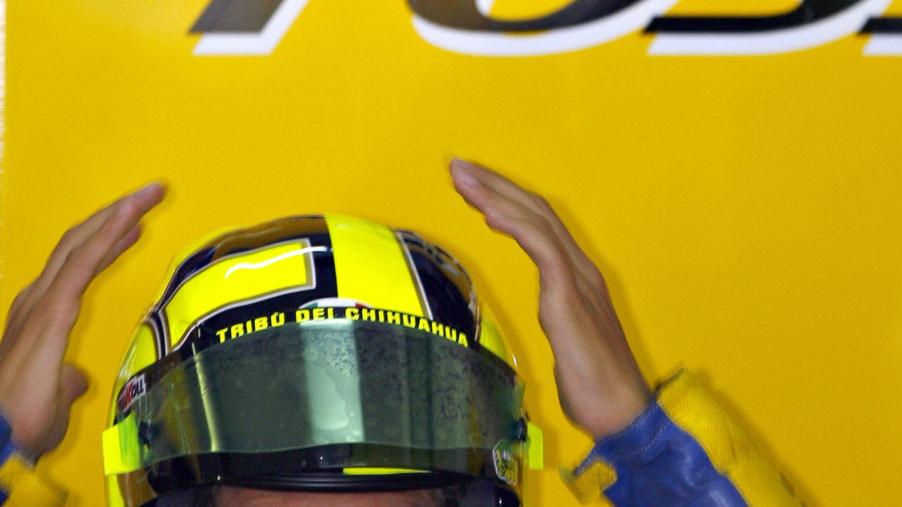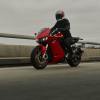
You Should Absolutely Make Sure Your Motorcycle Helmet Fits Properly
Loud pipes don’t save lives, but a solid motorcycle helmet can. Hence why it’s one of the most vital motorcycle accessories, if not the single most important one. However, it doesn’t matter how many safety organizations certified your helmet if you don’t wear or use it properly. And that means making sure it fits properly.
An ill-fitting motorcycle helmet isn’t just uncomfortable, it’s unsafe

Motorcycle helmets aren’t identical to auto-racing ones and don’t deal with the same kinds of impacts. However, some helmet guidelines are universal. Firstly, pick the helmet that’s most appropriate for the environment. You wouldn’t wear a dual-sport helmet to a paved racetrack, for example. And secondly, as with car-specific helmets, motorcycle helmets need to fit your head correctly.
Making sure your helmet sizing is spot-on isn’t just a matter of comfort. True, as with gloves and boots, an improper fit sours the ride. But in this case, comfort is secondary to outright safety. Whether your motorcycle helmet has a Snell, ECE, or just a DOT sticker, its safety rating is only valid if it fits correctly, RevZilla explains. If the helmet doesn’t fit snugly on your head, it can’t absorb and redirect impact forces properly. Instead, a big impact will knock the helmet into your skull, potentially causing additional injuries. And a loose fit can also interfere with other protective measures, such as the MIPS liners designed to curtail concussions.
However, a motorcycle helmet that fits too snugly is also no good. For one, an uncomfortably tight helmet is one you likely won’t want to wear. And a helmet only works if it’s on your head. Secondly, a tight helmet can cause circulation issues, pressure spots, headaches, and overall pain, distracting you during your ride. Plus, if you regularly wear glasses, a snug helmet might not leave sufficient room for them.
In short, when you go shopping for motorcycle helmets, a proper fit is a top priority.
Use—or rather, measure your head to make sure your motorcycle helmet fits
The simplest way to buy a motorcycle helmet that fits is to go to a gear shop and try helmets on one at a time. But not everyone has that kind of time; the ongoing pandemic also makes this tactic a bit risky. That being said, you’ll eventually have to try it on IRL and walk around for about 10-20 minutes. Not to just to confirm your size, but also to make sure the helmet isn’t creating any pressure spots, Cycle World says.
However, you can speed up the sizing and fitting process by measuring your head before going motorcycle helmet shopping. Take a flexible measuring tape and wrap it around the widest part of your head, roughly one inch above your eyebrows, Motorcyclist explains. If you don’t have that kind of measuring tape, you can also use your hat size if you know it. Then, check where your hat size or head measurement falls on the table below (courtesy of Motorcyclist). That’s your motorcycle helmet size.
| Motorcycle helmet size | Inches | Centimeters | Hat size |
| XS | 20 7/8 – 21 1/4 | 53-54 | 6 5/8 – 6 3/4 |
| S | 21 5/8 – 22 | 55-56 | 6 7/8 – 7 |
| M | 22 1/2 – 22 7/8 | 57-58 | 7 1/8 – 7 1/4 |
| L | 23 1/4 – 23 5/8 | 59-60 | 7 3/8 – 7 1/2 |
| XL | 24 – 24 3/8 | 61-62 | 7 5/8 – 7 3/4 |
| XXL | 24 3/4 – 25 1/8 | 63-64 | 7 7/8 – 8 |
| XXXL | 25 5/8 – 26 | 65-66 | 8 1/8 – 8 1/4 |
Note, the above table is a general guide, not an absolute one. Each motorcycle helmet manufacturer has a specific sizing chart. The helmets also have different shapes: some are rounder, others are more oval-shaped. And depending on your head shape, your measured size might feel loose or snug, Motorcyclist notes.
Double-check your fit and shape in the store, especially if you’re between sizes
Picking out the correct motorcycle helmet size is only the first fitting step, though. As noted earlier, try before you buy in the shop, preferably with an employee on hand. And once you do, there are a few things to pay attention to.
First, once you put the helmet on and secured the latch, push up on the back. If the helmet rolls forward easily, it’s too big. Then, push it horizontally; again, if it moves easily, it’s too big. If it puts pressure on your temples, it’s not round enough. But if it leaves a red line on your forehead, it’s not ovular enough, RevZilla explains. And while all full-face helmets push your cheeks up slightly, if they’re really being pushed up, the helmet is too tight. Ditto if it puts pressure on your forehead.
Speaking of cheeks, there’s a way to slightly modify a non-open-face helmet if you land between sizes. Swapping out the motorcycle helmet’s cheek pads changes how it sits on your head and face. So, if a Medium is too tight, but a Large is slightly too loose, try putting thicker pads in the latter helmet.
It’s worth noting that all new motorcycle helmets have a break-in period, just like boots and shoes. After a few riding sessions, though, the pads mold to your head, making the helmet fit even better. And that should keep you riding in safety.
Follow more updates from MotorBiscuit on our Facebook page.


